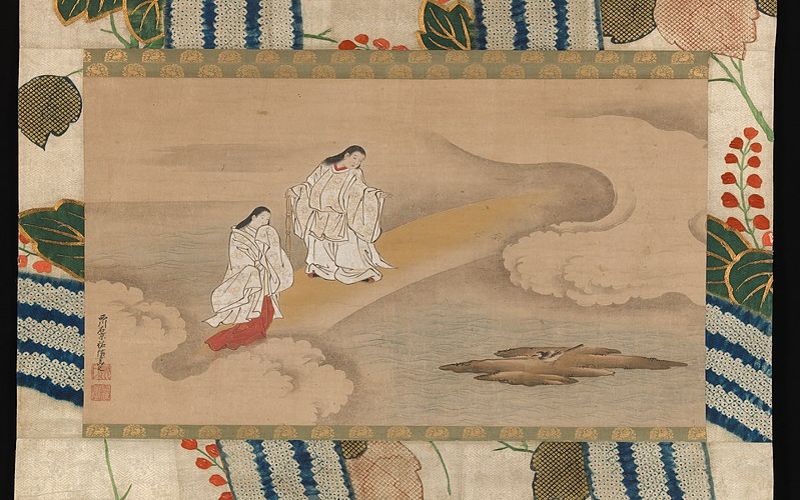We often look at life and death, creation and destruction as opposites that are somehow disconnected from each other. However, these opposites are actually closely connected, and without one side of the spectrum, there wouldn’t be another. Izanami is a Shinto goddess that embodies both life and death, creation and destruction.
Her story is reminiscent of other goddesses, but don’t let that fool you. Izanami is a unique and powerful deity that can change your life if you invite her. Keep reading to learn more about this mighty goddess.
Izanami’s Origin Story

In the Shinto religion, there were seven generations of gods that emerged after the creation of heaven and earth. Izanami, along with her brother/consort Izanagi, belonged to the seventh and final generation.
Together, Izanami and Izanagi created the first land. Their marriage union birthed several deities and several islands of the Japanese Archipelago. As such, Izanami became a mother goddess and the goddess of creation, but her role evolved over time.
Izanami’s Name Etymology
Izanami’s full name was Izanami-no-Mikoto, which means “She who invites.” Her brother Izanagi’s name means “He who invites.” Alternatively, their names can also be connected to the word isao/isawo, which means achievement or merit.
One of the oldest sources mentioning Izanami is Kojiki, an ancient Japanese chronicle that contains myths, legends, hymns, oral traditions, genealogies, and semi-historical records.
Izanami’s and Izanagi’s Union
At first, Izanami and Izanagi were sister and brother deities. Kunitokotachi and Amenominakanushi, the first Shinto gods, assigned Izanami and Izanagi the task of creating the first land.
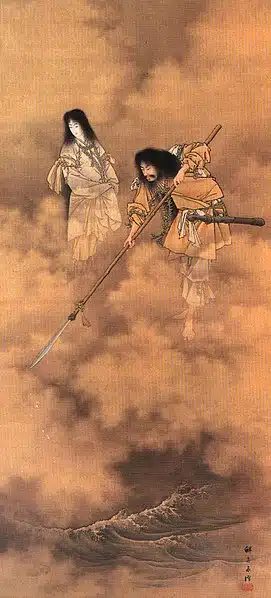
To do that, Izanami and Izanagi received a spear encrusted with jewels. They went to cross the bridge between heaven and the Earth and used their spear to chur the sea. A few drops of salty water fell from the spear onto the Earth and created the first land, a legendary island named Onogoroshima.
First Mating Attempt
Izanami and her brother made their home on Onogoroshima, from where they continued creating new land. Soon, they wished to marry and mate. To do that, they built a pillar and a palace around it.
Then, Izanami and Izanagi circled the pillar starting from opposite directions. They met on the other side of the pillar, and Izanami was the first one to greet her brother. Izanagi thought it was inappropriate but decided to mate with Izanami regardless.
This mating produced two children, Hiruko (who later became a god Ebisu) and Awashima. However, both children were born deformed, and as such, they weren’t considered deities. Horrified, Izanami and Izanagi placed their children into the boat and sent them to the sea.
Second Mating Attempt
Perplexed about what to do next, Izanami and Izanagi asked other gods for a piece of advice. The gods told them that, during the marriage ceremony, the male should speak first during the greeting.
Izanami and Izanagi decided to repeat their marriage ceremony, and Izanami allowed Izanagi to speak first. Finally, their marriage union was successful, and they could continue to mate.
From this union, Izanami and Izanagi created islands Awaji, Oki, Iyo (later Shikoku), Iki, Tsukushi (later Kyūshū), Yamato (later Honshū), Tsushima, and Sado. They also created other deities: Amaterasu, Susanoo, and Tsukiyomi.
Death Comes For Izanami
Izanami and Izanagi went on to create several other islands and deities, and everything seemed to go well for this couple. However, Izanami died while giving birth to Kagu-tsuchi, a fire deity.
Enraged, Izanagi killed his newborn child, creating dozens of new deities in the process. He buried his beloved sister and wife on Mt. Hiba. According to Kojiki, Izanama transferred her soul into an animal and a human before she died, but it remains unknown whether or not she had later incarnations.
The Trip To The Underworld
As Izanagi lamented the loss of his wife, he traveled to Yomi, “the shadowy land of the dead” – the Shinto version of the Underworld. He wanted to find his deceased wife and bring her back to the world of the living.
Soon, he found Izanami, but he couldn’t see her clearly because shadows surrounded her. Izanami told him that he had come too late because she already ate the food of the underworld, becoming the one with the underworld and unable ever to leave it.
Still, Izanami hoped that she would be able to get permission to leave the underworld. Izanagi was determined to bring her back to the world of living by any means necessary.
The Horrific Discovery
At one point, Izanami fell asleep. Izanagi wanted to see her, but the shadows were still obscuring Izanami’s body. That’s why he took a comb out of his long hair and set it on fire to use it as a torch.
When he could finally see his wife, Izanagi was horrified. His once beautiful and gracious wife was now covered in maggots and other foul creatures, with her body becoming rotted, full of wounds, and deformed.
Unable to control his emotions, Izanagi started crying out loud. He also started running towards the exit from the underworld, but his loud cries woke Izanami. She also started shrieking and chasing after Izanagi, sending some foul creatures after him.
A Nasty Divorce
Despite Izanami’s efforts, Izanagi managed to escape Yomi and come back to the world of the living. He placed a large boulder on the entrance to Yomi, forever separating the world of the dead from the world of the living.
By doing that, he also separated himself from his sister and wife, Izanami. As he was still standing by the boulder, he could hear Izanami approaching the other side of the boulder.
Enraged by his actions, Izanami threatened that if Izanagi left her there, she would destroy 1000 living people every day. Izanagi replied that if she did that, he would create 1500 new living people every day.
Finally, Izanagi left, and this was the beginning of the circle of life and death for humans. The goddess that created life became the goddess that took it away.
Izanami’s Role In Shinto Religion
As you can see from Izanami’s story, she serves two completely different roles in the Shinto religion. Her first role is during her life, while her second role is after her death.
The Goddess of Creation and Life
At first, Izanami is the mother goddess that creates new life along with her brother and husband, Izanagi. She creates the first land, several Japanese islands, and many other deities.
Just like a mother, Izanami is nurturing. She protects women and children, and she can even heal one’s wounds. In this role, she acts as a goddess of fertility, making sure her children and devotees have everything they need.
The Goddess of Destruction and Death
Once she dies, Izanami is no longer as nurturing and healing as she was. Now she rules over the souls of the deceased. However, this role is also important because the souls of the dead still need someone who will embrace and guide them.
Before her death, Izanami created a new life, but now she brings death. Once a beloved sister and wife, she is now feared and rejected by her brother and husband. Still, even though she changed so drastically, Izanami’s new role in the circle of life and death is essential for life to thrive.
“She Who Invites”
I found the literal meaning of Izanami’s name quite interesting. She who invites, it might sound unusual, but it actually makes sense for both of her roles.
As a mother goddess that creates new life and provides us comfort and protection, it is easy to see that Izanemi’s nature is inviting. Hence, “she who invites.”
However, while death may be scary, it is also inviting, as it brings peace from all of the pain and suffering that we experience while alive. Since the day we are born, death invites us, and we slowly walk towards her.
Shinto Rituals for Appeasing Izanami
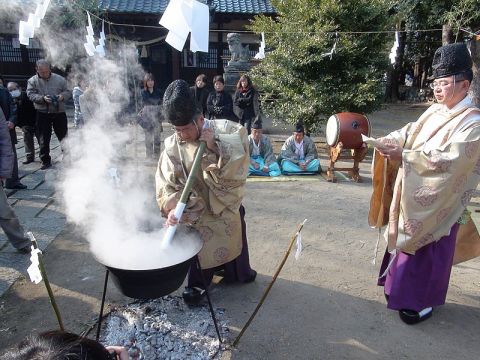
Shinto religion practitioners went through various rituals to appease their gods, also known as kami. These rituals are quite similar for all kami, and they consist of several different aspects:
- Purification – To properly worship a deity, one must go through ritual purification. Without this step, one might easily anger Izanami, and considering her power of life and death, that isn’t a smart thing to do.
- Adoration – Bowing to the altar or shrine of Izanami is another important thing to do because it shows adoration and respect for this goddess.
- Food offering – This is another way to express your servitude and gratitude to Izanami. The most popular food offerings are rice, salt, fruits, vegetables, sake, fish, sweets, etc.
- Prayer – Rituals for appeasing Izanami also include prayers in front of her shrine.
- Music and dance – Music and dance celebrate life, and as such, they are one of the ways to appease Izanami.
- Other offerings – Apart from food, there are symbolic offerings for appeasing Izanami. They usually consist of sacred tree twigs.
The Emotional and Spiritual Symbolism of Izanami’s Story
Izanami’s story is universal and can be found in some of its variations in many other cultures and religions. It is a story of life and death and how these two are closely connected to each other.
A Cycle of Life and Death
Japanese people believe that Izanami created everything and that she inspires us to be creative and inventive as well. She provides comfort and security for those that worship her.
Additionally, Izanami serves as a symbol of strong feminine power and fertility. This power is responsible for all life around us, and without it, the universe would be a vast desert.
However, everything in life has its end, and so does life itself. Izanami is the one that creates life and brings it into the world, but she is also the one that ends it and takes it to the world of the dead.
Without death, life would become overly abundant, and it would soon become unsustainable. Without the comfort of death, living creatures would be forced to live forever. Soon enough, such life would no longer be enjoyable, and instead, it would turn into endless suffering.
Everything Ends
Nothing lasts forever but the earth and sky, says one popular song and truer words have never been said. This is true for everything in our lives, as everything has to end eventually. This might sound depressing, but it is a good thing.
Imagine if you had an issue that would never end. That would be horrifying. Now, on the other side, think of things that make you happy. Would you still enjoy them as much as you do if you knew they would never end? You know that the answer is negative.
This transience is what makes life so interesting. It helps us appreciate things that we have, and without it, everything would soon become dull, in the best-case scenario.
Even the death that we so fear is our friend. Imagine if we had to live forever, but our bodies slowly deteriorated. Or even if we stayed forever young and healthy, after several hundreds of years, nothing would surprise us, make us happy or sad, or produce any other emotion.
Death makes all of our problems seem less important. No matter how important these things seem to us, they all fade away when life ends. Once you die, none of the things that worried and annoyed you will matter.
Izanami’s Relationship to Other Shinto Goddesses
As a mother goddess that created countless other deities, Izanami is closely connected to many other Shinto goddesses. Probably the most significant relationship is with Amaterasu, Izanami’s daughter.
In some versions of Amaterasu’s origin story, Amaterasu has only one parent, as she was born from Izanagi’s weeping eyes. Even in that case, Amaterasu would be Izanami’s niece and some sort of stepdaughter.
Her other daughters are Mizuhanome (the goddess of water), Toyoukebime (the goddess of agriculture), and Haniyasu-hime (the goddess of clay, earth, and pottery.
Izanami also had many grand and great-granddaughters, some of which are Ukemochi (the goddess of food), Konohanasakuya-hime (the goddess of Mount Fuji and all volcanoes), and many others.
Izanami’s Appearance and Depiction
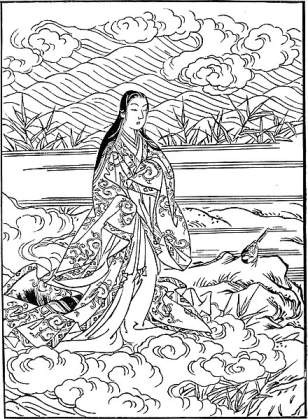
When she was alive and the goddess of life and creation, Izanami was a beautiful goddess with long flowing hair, sometimes depicted as dressed in traditional Japanese robes. Since she is also the goddess of fertility, Izanami would often wear a crescent moon on her forehead.
When she died, Izanami’s appearance changed dramatically. She was no longer beautiful and gracious, as her body started rotting and became infested with maggots and other parasites.
In art, Izanami is usually depicted with her brother, standing on the bridge between the heaven and earth, carrying the powerful spear that will create so many new things on the empty earth.
Izanami And Her Christian Renditions
Shinto religion is completely different from Christianity and other Abrahamic religions. This is why it is so hard to compare Shinto deities to any of the Christian figures or saints. Some compare Izanami to Virgin Mary, as both are mother figures that nurture those who worship them.
However, since Izanami is so closely connected to death, she is much more similar to Jesus. According to Bible and Christian beliefs, Jesus Christ had to die in order to atone for all of our sins. But his death was only temporal, as it was a way to resurrect and live an eternal life.
Izanami never resurrected, despite her husband’s efforts to bring her back to the world of the living. Still, without death, there would be no life, and this is a somewhat loose parallel between Izanami and Jesus Christ. For both of them, death isn’t the end of life.
Izanami-Like Goddesses From All Around The World
The first goddess that comes to mind that’s somewhat similar to Izanami is definitely Persephone. Both Izanami and Persephone went down into the underworld and ate some food there, which made them forever bound to the world of the dead.
Both goddesses accepted their fate and took over their duty of ruling the underworld. The only difference is that Persephone spent half of the year in the world of the living, while Izanami had to stay in the world of the dead without a chance to get out.
Another goddess that is similar to Izanami is Kali. Just like Izanami, Kali rules over the cycle of life and death. She is the goddess of death and the battlefield, but she also represents life, love, fertility, and change.
Finally, we have Morrigan, a Celtic goddess of death, war, and transformation. Apart from bringing death and being feared by many, Morrigan also has a softer aspect. One of her manifestations was Ériu, a goddess of fertility, abundance, and agriculture.
Legacy
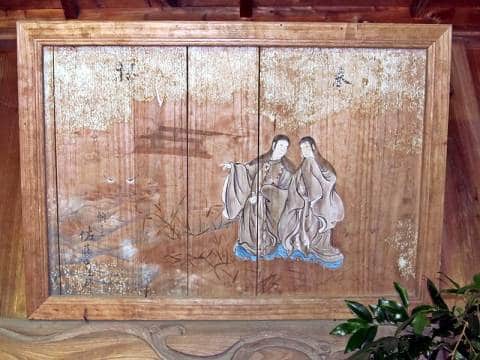
Izanami’s legacy is still strong among the people of Japan. Shinto rituals are still performed all over Japan, and millions of religious Japanese people identify as Shinto believers. Naturally, they all worship Izanami as a powerful goddess that can bring both life and death.
Apart from her legacy in the context of modern Japan, Izanami’s legacy also in teaching us that everything must come to an end. She teaches us that this isn’t a bad thing. Everything coming to its end opens up the possibility for a change and for new things to happen.
Instead of fighting the change and inevitable transience of life, we should accept it as a natural thing. Remembering that everything ends should motivate us to cherish everything we have.
Finally, Izanami is the goddess of creation, and as such, she inspires us to create new things. when it comes to these new things, there are no rules: we can paint, compose, write poems, build houses, and birth children; the possibilities are endless. The bottom line is, we should focus our energy on creating new things that will make the world a better place.
Symbols
Every goddess has symbols that help us come closer to her. These symbols are often physical items that were connected to the goddess or were part of her depictions. As their name says, goddess symbols have deeper symbolic meanings, closely connected to the goddess’ powers.
Since Izanami is the goddess of both life and death, her symbols reflect this duality. By learning more about these symbols, you will be able to introduce Izanami into your life more easily.
General
This might surprise you, but one of the most common Izanami symbols is poetry. In Japan, people believe that Izanami is the creator of all things, and as such, she inspires us to create new things too. Poetry is one of the best ways to be as creative as Izanami.
Other arts, such as dance, music, sculpture, painting, etc., are also great symbols of Izanami, as they symbolize her role in the creation of the world as we know it.
Animals
Not much can be found on animal symbols of Izanami, but since she is the goddess of fertility, birth, and life, any animal that carries that symbolism can be Izanami’s symbol. Rabbits, bees, cows, and frogs are only some of the animals that represent fertility and the creation of new life.
Izanami is also the goddess of death. Animals that symbolize death, such as bats, crows, ravens, moths, maggots, etc., can symbolize Izanami perfectly.
Plants
If you want a plant that will symbolize Izanami’s creator and fertility role, choose orchids, lotus flowers, peonies, poppies, cornflowers, and lilies. On the other hand, if you want a plant that will symbolize Izanami’s destructive nature, choose chrysanthemums, carnations, and hyacinth flowers.
Perfumes/Scents
Some of the best scent notes to represent Izanami are incense, labdanum, myrrh, jasmine, and violets. They perfectly capture Izanami’s femininity and beauty while also hinting at her darker side.
Gems and Metals
Moonstone represents fertility, but due to its connection to the moon, it also represents the darker aspect of life, and as such, it is a perfect symbol for Izanami. Some other options are black pearls, rose quartz, and opals.
Goddess Jewelry
There are many reasons why you might want to keep a healing crystal or stone close to you. Getting closer to your goddess by wearing her color or crystal is a great one. That they also look great as jewelry only makes it so much better!
Here is a guide to crystal jewelry you hopefully will find helpful. In it is a list of 30+ crystals and links to some really great looking jewelry with that crystal or stone. Enjoy!
Colors
In the traditional depictions of Izanami, she is wearing white robes, so the white color definitely suits her as a symbol. Alternatively, pastel colors, such as lilac or rose pink, also symbolize Izanami’s femininity and fertility.
However, red, black, and green are more suitable to symbolize Izanami’s role as the ruler of the underworld.
Meditations
- Izanami, you create and take away life, have mercy on my family and me
- Give me your creative power and make me resourceful and innovative
- Help me accept that everything changes and that all things come to an end
- Help me deal with the end of my relationship/marriage and accept that I need to move on
- Provide me with wisdom to know when I need to control my destructive energy and when to unleash it
- Make me fertile and a good mother as you are, Izanami
Want To Bring More Izanami Qualities Into Your Life?
- Write poetry. If you aren’t so skillful at writing verses, try writing a short essay. You don’t have to be talented in writing, but writing down your thoughts or some interesting events will boost your creativity and act cathartically to your mind.
- Try some different forms of artistic expression. Who knows, maybe you will uncover some hidden talents? Regardless, you will definitely enjoy the feeling of creating something new, even if you don’t feel particularly talented or successful. Don’t worry about talent and success, and don’t compare yourself to others. Simply enjoy the act of creation.
- Surround yourself with Izanami symbols. Wear her colors, and buy a perfume that has Izanami scent notes in it. Plant some lilies in your garden, or buy yourself an orchid houseplant.
- Start gardening. This is another way to create and nurture something new, and even if you fail sometimes, it is not the end of the world. After all, it’s the cycle of life and death.
- Bring some changes into your life. Is your every day the same as the one before? Spice things up a little bit! Find a new hobby, rearrange your home furniture, change the color of your hair, the options are endless!
- Do you feel unfulfilled and miserable in your relationship? Or is some other type of relationship smothering you? Consider which relationships are worth saving and fighting for. Those that aren’t worth saving should be ended. All sides will be much happier about it.
Featured Image Credit: Nishikawa Sukenobu, Public domain, via Wikimedia Commons

